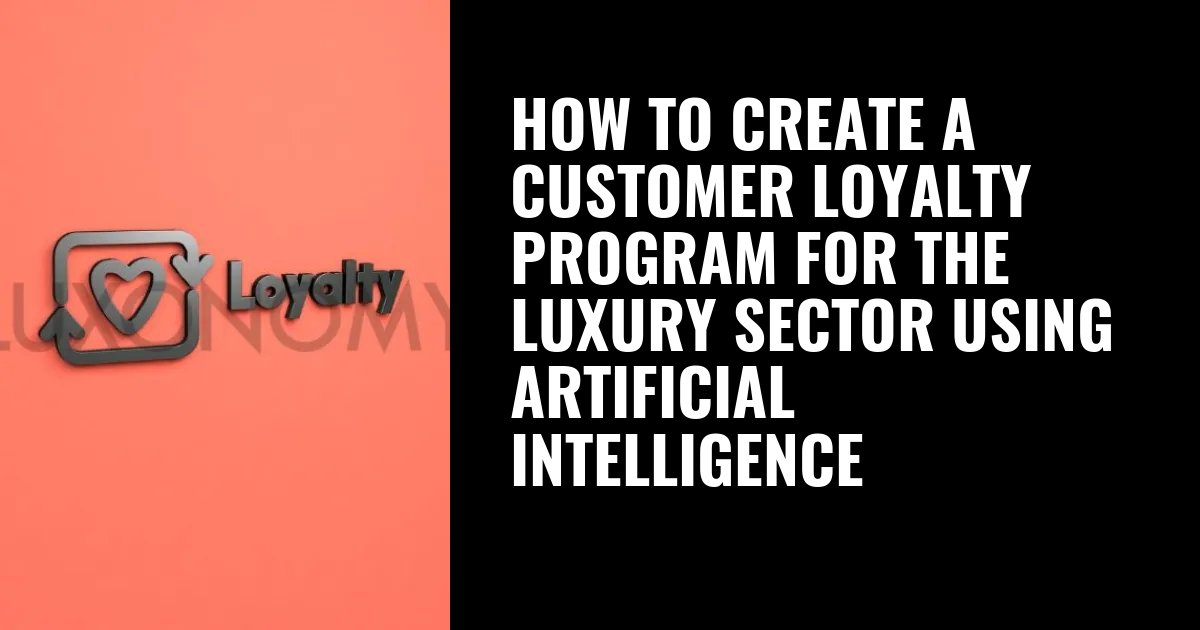How to create a Customer Loyalty Program for the Luxury sector using Artificial Intelligence

Chairman LUXONOMY™ Group
Index
- Introduction
- Customer Segmentation and Analysis
- Personalizing the Customer Experience
- Creating Exclusive Benefits and Rewards
- Implementing Luxury Chatbots and Virtual Assistants
- Predictive Analytics and Proactive Customer Retention
- Using Blockchain for Transparency and Exclusivity
- Continuous Measurement and Optimization
- Omnichannel Integration and Brand Consistency
- Data Ethics and Privacy
- Feedback and Continuous Improvement
- How to Implement the Program Technically
- Conclusion
How to Implement the Program Technically
To technically implement a customer loyalty program for the luxury sector using artificial intelligence (AI), a series of key steps must be followed, including technology selection, systems integration, and data management. Here’s a detailed technical plan:
1. Selection of Platforms and Tools
- Customer Relationship Management (CRM) Platform: Choose a CRM platform with advanced AI integration capabilities. Platforms like Salesforce, HubSpot, or Microsoft Dynamics allow easy integration of AI modules and data analytics tools.
- Data Analytics Tools: Implement data analytics tools such as Google Analytics, Tableau, or Power BI to analyze customer behavior and segment them appropriately. These tools should be compatible with the selected CRM platform.
- AI-Based Recommendation Engines: Use recommendation engines like Amazon Personalize or Google Recommendations AI to provide personalized product recommendations to customers.
2. Data Collection and Management
- Integration of Data Sources: Connect all relevant data sources (physical stores, online, mobile apps, social media) to a centralized database. Use APIs for efficient data integration to ensure customer information is always up-to-date.
- Secure Data Storage: Use cloud storage solutions (such as AWS, Azure, Google Cloud) to handle large volumes of data. Ensure these solutions comply with data privacy regulations (GDPR, CCPA).
- Data Cleaning and Enrichment: Implement automated processes for data cleaning and enrichment to ensure customer information is accurate, complete, and usable for segmentation and personalization.
3. AI Development and Integration
- Development of Predictive Models: Use machine learning tools like TensorFlow, PyTorch, or Scikit-Learn to develop predictive models that can forecast customer behavior and recommend proactive actions.
- Training AI Models: Collect historical data to train AI models. Use supervised and unsupervised learning techniques to develop models that can segment customers, predict churn, and suggest personalized recommendations.
- Integration of Chatbots and Virtual Assistants: Use platforms like Dialogflow, Microsoft Bot Framework, or IBM Watson Assistant to develop and integrate advanced chatbots and virtual assistants that provide real-time support and recommendations to customers.
4. Implementation of Data Security and Privacy
- Compliance with Privacy Regulations: Ensure all tools and platforms used comply with data privacy regulations. Implement encryption and data anonymization solutions to protect customer information.
- Customer Consent and Transparency: Implement clear mechanisms for obtaining customer consent for data collection and usage, and provide options for customers to manage their privacy preferences.
5. Omnichannel Integration
- Real-Time Data Synchronization: Implement real-time data integration solutions to ensure customer information is synchronized across all channels (physical stores, online, mobile apps).
- Consistency in Customer Experience: Use Customer Experience Management (CEM) tools to ensure the brand experience is consistent across all customer touchpoints.
6. Continuous Measurement and Optimization
- Implementation of KPIs and Performance Metrics: Define and implement clear KPIs to measure the success of the loyalty program, such as customer retention rate, customer lifetime value (CLV), and customer satisfaction.
- Data-Driven Optimization: Use data analytics and machine learning algorithms to continuously adjust the loyalty program based on customer behavior and achieved results.
7. Launch and Ongoing Support
- Pilot Launch: Start the program with a pilot launch for a select group of customers and gather feedback to make adjustments before a full launch.
- Continuous Technical Support: Provide ongoing technical support to troubleshoot issues, perform updates, and optimize system performance.
Conclusion
The technical implementation of a customer loyalty program for the luxury sector using artificial intelligence requires careful planning, the selection of appropriate tools, and the integration of advanced data management and predictive analytics systems. With an omnichannel and customer-centric approach, the program can deliver personalized and exclusive experiences that strengthen customer loyalty and drive long-term growth.
Make a one-time donation
Make a monthly donation
Make a yearly donation
Choose an amount
Or enter a custom amount
Your contribution is appreciated.
Your contribution is appreciated.
Your contribution is appreciated.
DonateDonate monthlyDonate yearlyShare/Compártelo
- Click to share on LinkedIn (Opens in new window) LinkedIn
- Click to share on WhatsApp (Opens in new window) WhatsApp
- Click to share on Facebook (Opens in new window) Facebook
- Click to share on X (Opens in new window) X
- Click to share on Threads (Opens in new window) Threads
- Click to email a link to a friend (Opens in new window) Email
- Click to print (Opens in new window) Print
- More
Related
Discover more from LUXONOMY
Subscribe to get the latest posts sent to your email.




















